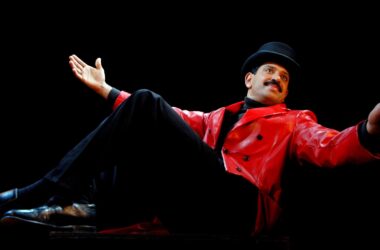[ad_1]
Felicia “Snoop” Pearson is running a few minutes late to a joint interview alongside her writing partner Ed Burns, so Burns fills the time with a helpful story about one of the few other instances of her truancy.
More than two decades ago, the actor Michael K. Williams had asked Pearson to accompany him onto the set of “The Wire” after she brazenly introduced herself to him at a Baltimore nightclub.
Burns, who with David Simon cocreated the landmark show that explored institutional failures, admired her distinct tattoos and gravelly Baltimore drawl. Williams and some of the actors vouched for Pearson as an authentic resource who would give the show additional credibility.
Burns had a spot on the show for her, he promised, if she limited any illicit activity and showed up the next week.
The day Pearson was to appear on camera, Burns said, he received a frantic phone call. “I didn’t know the car was stolen,” Pearson hurriedly began.
Through some deciphering, Burns discovered that Pearson had visited New York with friends for Pride Week. During the journey, they noticed a cop car’s flashing lights and pulled over. The driver of the car had no idea the vehicle he had purchased was stolen. Police searched Pearson, discovered a pocketknife and took her into custody. She did not make call time.
Burns reassured her that he would cast her again.
“Two weeks later, she was there,” he said. “And she was there on time, if not before, every time after.”
The investment kick-started Pearson’s reign as one of television’s most harrowing characters, a dedicated female street soldier in a drug dealing crew also called Snoop who was equal parts detached and calculating.
To form this character, Pearson reflected on the harsh realities of her east Baltimore upbringing, conjuring a fictionalized version of herself who the horror writer Stephen King described as “perhaps the most terrifying female villain to ever appear in a television series.”
“Sometimes I just go back and just hear my voice and I’d be like, ‘Damn, people really had to put the caption on their TV to really know what I was saying,” Pearson laughed, once she made it onto the video call and apologized for taking cold medicine that left her sluggish.
Talking about her first days on the set of “The Wire,” Pearson, then in her early 20s, compared the experience to being in a courtroom, with a mostly white crew judging her performance. The tension faded thanks to the cross-generational bond she formed with Burns, the nearly 60-year-old former homicide detective and middle-school teacher whose experiences informed the show that has come to be seen as one of the best of all time.
Burns, whom she affectionately calls “Pops,” became her confidante and it was a relationship that outlasted the show, which aired its final episode in 2008.
Recently, the pair wrote a limited-series television show, “A.K.A. Snoop,” based on Pearson’s life that explores the environment Pearson endured growing up in Baltimore. It explores the brutality of growing up in a poor, racist society, “in a way that you only glimpse in other shows,” Burns said. “It’s all focused on this one child and her journey, and what evolves around her and what it takes for her to become what she became in order to survive.”
They plan to shop the show in spring amid a challenging environment, as the era of Peak TV draws to a close and studios greenlight fewer scripted projects.
“Obviously, I am rooting for Ed and Snoop,” Simon wrote in an email. “And yes, everything about Felicia’s story is compelling.”
The show exists in the Baltimore crevices that created “The Wire,” a fictional show that depicted institutions failing the masses. But the new project narrows its lens, depicting factual snippets of her life for a story of survival and resilience in spite of lurching systems.
“I’m Black, gay, got a criminal background,” Pearson said. “Every strike that’s against Black people, I got them.”
The series would showcase some pivotal moments in Pearson’s early life, starting with her being born three months premature to a crack-addicted mother. Later there’s Pearson at 4 years old, decked out in a new dress and waiting to meet the absentee mother who quickly locks her in a closet and strips off her clothes to sell in order to score drugs. By third grade, the impish Pearson smashes a bully over the head with a bottle.
The altercations continued, culminating when Pearson was 14 years old. Then, she killed 15-year-old, Okia Toomer, who Pearson said had come after her with a baseball bat in a crowd. Pearson was convicted of second-degree murder and served nearly seven years at the Maryland Correctional Institution for Women in Jessup, Md.
After her release, Pearson tried straightening out her life. She earned her G.E.D. and landed a job crafting car bumpers only to be fired, she says, when her employer learned of her felony conviction.
Soon after, Pearson found herself on the set of the “The Wire,” more out of curiosity — some of her homeboys had been talking about a show filmed around the corner from her grandmother’s house — than any fanciful hopes of becoming the next Cicely Tyson.
Yet Pearson ended up at the center of some of the show’s most indelible moments. Burns wrote one such scene specifically for Pearson: the season-four episode that opens with her character visiting a hardware store to purchase a nail gun. As a store employee goes over the technical details of the store’s best offering, it slowly dawns on him that the savvy customer with a haunting mix of curiosity and humor about firepower might not be in the construction business.
When Snoop pays him in cash, with a healthy tip, the employee protests. “You earned that bump like a [expletive], man,” she replies before toting the nail gun out of the store.
Pearson has been trying to tell her own story since those appearances, publishing in 2007 an memoir, “Grace After Midnight,” written with David Ritz, and later paying a screenwriting service for what she deemed to be a subpar retelling. Reviewing the script, Burns bluntly told her she had been ripped off.
She and Burns never lost touch after “The Wire” ended, but though Pearson sometimes sought out Burns’s advice, she didn’t always follow his earliest warning to stay out of trouble. In 2011, Pearson was arrested on drug charges and she received a suspended seven-year prison term.
During the pandemic, she hesitatingly approached Burns about working with her to adapt the book; Burns told her he had been waiting for her to ask. “I was like, ‘This could have been my first stop,’” Pearson said.
Working together would take time and be exhausting, Burns cautioned. He knew of Pearson’s affinity for gangster films, but knew he would need to prod her for stories on her childhood.
“Sometimes it was emotional,” Pearson said. “Sometimes, it just flowed out because I’m used to telling people how I feel.”
The pair exchanged ideas and scripts throughout much of the pandemic. Burns purchased Pearson a laptop and taught her how to use the popular screenwriting software, Final Draft. Pearson bought Burns an iPhone and tutored him on communicating more quickly.
Since “The Wire,” Pearson has appeared in Spike Lee’s films “Da Sweet Blood of Jesus” and “Chi-Raq,” the long-running reality show “Love & Hip Hop: New York,” and the recent Mark Wahlberg vehicle “The Family Plan.” She lives in New York now and while she admits the search for new roles can run cold, her acting career is more than she could have dreamed of as a 20-something with no experience. Pearson never achieved the levels of fame of some former castmates like Idris Elba and Michael B. Jordan, who became box office stars, or the late Michael K. Williams, who worked steadily across film and television.
Pearson describes Williams, who died in 2021 of a drug overdose, as her protector. His death still affects her. She said she recently became emotional watching him on TV in the 2016 “Ghostbusters” reboot.
“Sometimes, you go crazy, but you not crazy,” Pearson said. “You hurting.”
Burns, who has collaborated with Simon on various shows since “The Wire,” said he wanted to offer Pearson the same break that Williams did all those years ago. But this time, she’s not an ensemble player. She’s the center.
“I come from Baltimore, so it ain’t no pressure at all because it’s my life story,” Pearson said. “Lord have mercy, it’s going to have you crying, laughing. All the emotions that you ever felt in your body or in this world.”
Source link








